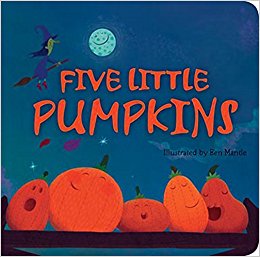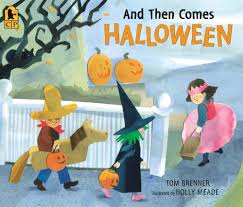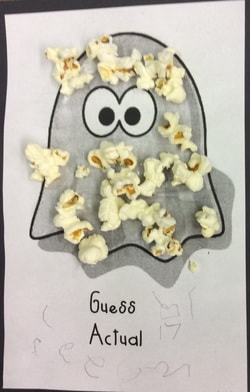|
With Halloween only two days away, I am wondering how teachers are connecting with their students' interests in this holiday to design engaging Mathematical learning experiences. There are some outstanding children's literature books that provide wonderful connections to mathematical concepts. Some of these include:
 How Many Seeds in a Pumpkin is a classic. Using a class pumpkin, or individual student pumpkins, students can: - estimate how many seeds will be in their pumpkin - use a graph to help them determine how to carve the class pumpkin - estimate and then measure the circumference of their pumpkin using strings - estimate and measure the height of their pumpkins using cubes - count the number of lines around the pumpkin
 Another fun Halloween book is 2x2 = Boo! This book can be used to explore multiplication. Similar to the classic game Circles and Stars by Marilyn Burns, students can roll two dice and play "Spiders and Webs". Students will need cotton balls or large elastics for the webs and some mini spiders, which can be found at the dollar store this time of the year. The first dice rolled represents the number of webs the students will need to make and the second roll will represent the number of spiders they need to place in each web. They will build these. Then using a whiteboard students can explore writing a "groups of" statement (e.g., 4 groups of 8 spiders is 8 + 8 + 8 + 8 or 4 x 8). Recently I visited some Grade Three classes to engage in Number Talks. I used images of Halloween cookies placed in arrays to spark multiplicative thinking. The students were able to see the equal groupings and made connections between repeated addition and multiplication, as well as the commutative property (e.g., a x b = b x a). I've shared these images under the Instructional Ideas tab so that others may used these and the app Skitch to have similar discussions with their students.
This is just a small sample of ideas. There are many other Halloween books, including Franklin's Halloween where you could delve into looking at combination problems. Others I'm excited to check out include Bats on Parade and Bat Jamboree! I would love to hear more about your favourite Halloween children's books and any Halloween'y Math lessons you've tried. Please leave some ideas/comments below!
2 Comments
In September of 2015, the Surrey School District began its Changing Results for Young Mathematicians initiative, as part of the British Columbia Provincial Numeracy Project. Several District's were involved, each enacting the project in different ways. In Surrey, the initiative took a similar format to Changing Results for Young Readers and followed the key phases of the Spirals of Inquiry written by Linda Kaser and Judy Halbert. Teachers began by spending time closely scanning their students and selecting a case study student based on questions that were emerging from their observations. Through reviewing the information they collected, they began to focus in on one area and asked themselves "What might I be able to do that could make a difference for this child in relation to..." Some of the teachers' questions included trying to build students' confidence in math, fostering students ability to communicate their understanding, improving a students' number sense, assisting students' in developing a growth mindset and positive disposition towards math, and building students' conceptual understanding of mathematical concepts. Each of the teachers took different actions to achieve results. Every six weeks we would come together as a group to check in and collaboratively reflect upon our actions. We asked "What did you try? What did you observe? What worked? What didn't? Where to now?" Generally speaking, teachers participated for two years. This cyclical process continued every six weeks and ended in June with teachers capturing the process of inquiry through writing two learning stories: the first included the story of their case study student; and the second story was their own. This year we have 13 teachers who are participating in their second year. They come from the following five schools: Hjorth Road, William Watson, White Rock, Cambridge, and Beaver Creek and teach Kindergarten through Grades Five. During our first session last Wednesday afternoon, we began by forming a circle and "arriving". Each of us took a turn sharing a bit about our experience last year in the initiative and finishing our sharing with the following phrase "... and that's what brought me here today!" It was evident through what was shared, each teacher realized the powerful, positive transformations that can occur both for themselves professionally, as well as for their case study students when they participate in a collaborative professional inquiry. Following our "arrival" we broke into three small groups and each group was tasked with re-creating the spiral of inquiry. They were given red yard, the key headings (e.g., Scanning, Developing a Hunch, Focusing, New Learning, Taking Action, and Checking), descriptions of the headings from the article linked above, and excerpts from the learning stories these teachers had written at the end of last year. It was so interesting to see how each group created a different shaped spiral. The discussions were rich... "should 'new learning' come before taking action, as we need to learn before we move forward OR should it come after checking, as we learn from checking what is working and what isn't and based on this we enter the cycle again." And "it sounds like this teacher shifted her question based on what she observed, so do we need to take and create another circle on top of the first, as she is in her second cycle?" Each group asked for more yarn as they felt there wasn't enough to show the recursive nature of inquiry. Although all names had been removed, the teachers smiled when they read excerpts they had written. This activity helped us to reconnect with the important work ahead of us. Next, it was time to delve in. We chatted about how we were getting to know our students. What were we noticing? Beyond gathering initial Numeracy assessment (e.g., WDTK, Early or Late Numeracy Assessment), we wondered what questions we should be paying attention to when selecting our case study student? We were appreciative of Carrie Gelson's blogpost on "The Power of Observation" where she suggested powerful questions teachers can ask themselves during daily classroom activities to help them learn about their new students. For example, during a math activity, Carrie asks "Who is a self-starter? Who takes risks? Who likes to work with others? Who is persistent?" These are important considerations. We discussed what other questions came to mind when thinking about our own classroom contexts. Letting the answers to these questions, as well as any other information the teachers had gathered, guide us, we requested that by our second session in October the teachers would return having selected a case study student and with a completed scanning template. These teachers collaboratively created this template last year. We really look forward to another year of collaborative professional inquiry - working together, remaining curious, asking important questions, checking out hunches, delving into new learning, and taking action for our deserving students! Together we can and will make a difference!
Note: I use the pronoun "We" throughout, as I have the good fortune of working with my friend and colleague Ginny Tambre, Surrey School District's Changing Results for Reading Advocate, to collaboratively plan our sessions. |
About Me
I am a Numeracy Helping Teacher with the Surrey Schools District. Each day I am thankful for being able to work with amazing students and teachers in an area I am passionate about ~ Mathematics! Subscribe:Click the RSS feed button
Archives
October 2018
Categories
All
|
|||||||||||||||||||||































 RSS Feed
RSS Feed
